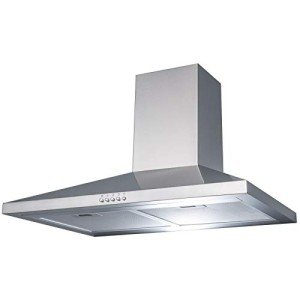It Is The History Of Chimney Cooker Hoods

Understanding Chimney Cooker Hoods: A Comprehensive Guide
Chimney cooker hoods have become a staple in modern kitchens, combining performance with elegant aesthetic appeals. These ventilation systems are developed to remove smoke, odors, and airborne grease from the kitchen, enhancing air quality while complementing kitchen décor. In this blog post, we will check out different elements of chimney cooker hoods, their advantages, types, installation tips, and upkeep suggestions.
What is a Chimney Cooker Hood?
A chimney cooker hood, typically called a chimney hood, is a kitchen home appliance installed above the cooking range to extract smoke, grease, steam, and odors while cooking. Its style features a vertical structure looking like a chimney, offering it its name. These hoods can be ducted (venting air outside) or recirculating (filtering and reintroducing air), dealing with varying kitchen setups.
Key Features of Chimney Cooker Hoods
| Feature | Description |
|---|---|
| Style | Streamlined and modern, fits various kitchen styles |
| Sizes | Readily available in numerous widths and heights |
| Filters | Generally equipped with grease and charcoal filters for ideal efficiency |
| Controls | May consist of buttons, touch, or push-button controls |
| Lighting | Features integrated lighting for better exposure while cooking |
Benefits of Using Chimney Cooker Hoods
-
Improved Air Quality: Chimney hoods effectively remove harmful vapors, making sure a much healthier cooking environment.
-
Odor Elimination: They help get rid of cooking odors, preventing them from settling in furnishings or upholstery.
-
Grease Reduction: A chimney hood limits grease accumulation on surface areas, making kitchen cleansing much easier.
-
Improves Kitchen Aesthetics: Available in various designs, they can function as a centerpiece in kitchen design.
-
Increased Kitchen Comfort: By enhancing air circulation, they make cooking more pleasant, specifically in confined kitchen spaces.
Kinds Of Chimney Cooker Hoods
Chimney hoods come in various types, each created to fit particular requirements. Here are the most typical types:
| Type | Description | Pros | Cons |
|---|---|---|---|
| Wall-Mounted | Installed versus a wall above the cooking range. | Space-saving, elegant, and versatile. | Requires wall space; might be more costly. |
| Island | Suspended from the ceiling above an island cooking range. | Provides visual appeal and effective ventilation. | Installation can be complicated; greater expense. |
| Under-Cabinet | Installed under kitchen cabinets. | Ideal for kitchens with minimal area. | Less visual appeal; might restrict air flow. |
| Integrated | Integrated into kitchen cabinets for a smooth appearance. | Concealed design, optimizes space. | Normally more expensive; might restrict power. |
Installation Tips for Chimney Cooker Hoods
Installing a chimney cooker hood can be an uncomplicated process, however correct standards must be followed. Here is a list of important setup pointers:
-
Select the Right Height: The perfect height for installation is typically between 26-30 inches above the cooking surface.
-
Consider the Ductwork: Ensure appropriate ducting remains in location if you choose a ducted design. Brief, straight duct runs lessen loss of suction.
-
Confirm Electrical Needs: Check the hood’s specifications for electrical requirements and make sure appropriate circuitry.
-
Follow Manufacturer Instructions: Each brand name might have unique procedures; always describe the maker’s guide.
-
Protect Proper Ventilation: Ensure correct ventilation outside the home for ducted hoods, preventing backdrafts.
Frequently Asked Questions About Chimney Cooker Hoods
1. How do I understand which size chimney hood to buy?To figure out the correct size, consider the width of your cooking range. The hood needs to match or be a little bigger than the cooking device, typically 3-6 inches wider.
2. Do chimney hoods work without ducting?Yes, recirculating (non-ducted) models can filter and purify the air before releasing it back into the kitchen. Nevertheless, they may be less effective than ducted variations.
3. How often should I clean the filters?It’s advisable to clean grease filters monthly and change charcoal filters around every 6 months, depending on usage.
4. Can chimney hoods be utilized over all types of cookers?A lot of models appropriate for gas and electric cookers. However, examine the manufacturer’s standards to guarantee compatibility.
5. What is the average expense of chimney cooker hoods?Prices vary considerably, varying anywhere from ₤ 100 for fundamental designs to over ₤ 2,000 for high-end, designer versions.
Upkeep of Chimney Cooker Hoods
To make sure longevity and efficient efficiency of chimney cooker hoods, regular upkeep is important. It can avoid breakdowns and maintain ideal duct efficiency.
Upkeep Checklist
- Clean the Filters: Remove and clean grease filters routinely.
- Examine the Fan: Inspect and clean up the fan and motor to ensure they function properly.
- Inspect Ductwork: Periodically check ducts for obstructions or buildup.
- Polish the Surface: Use proper cleaning products to avoid scratches and maintain shine on the exterior.
- Evaluate the Lighting: Regularly examine light functions and replace burnt-out bulbs quickly.
Chimney cooker hoods are an integral part of modern kitchen design and performance. They boost the cooking experience while effectively improving air quality. With different designs and choices readily available, discovering the best chimney hood to suit your requirements ends up being a possible job. By comprehending their types, benefits, and maintenance, one can make educated decisions, making sure a beautifully ventilated kitchen for several years to come.



